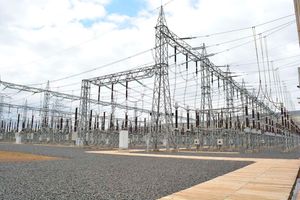
A Garissa University student and family members of those killed appear in court during the judgment that ordered the state to compensate the victims.
On the dawn of April 2, 2015, al-Shabaab militants attacked Garissa University and took many students hostage, singling out some for execution.
The horror reverberated across the world. The university fraternity and relatives and friends of the 148 students killed were traumatised. Seventy nine learners were seriously injured, some paralysed for life.
A plaque at the institution to commemorate those killed reads: “This monument was constructed in memory of 148 souls massacred in cold blood. Verily, the power of education will never be silenced even by the deadliest gun.”
Like the words on the inscription, the bloodbath did not silence the quest for education. Garissa University is rising.
The brazen attack hit the institution hard, with student enrolment down to almost zero. Many Kenyans shunned Garissa University. Only 388 were on the campus in 2016.
Almost 10 years after the horrifying attack, things have taken a turn – for the better. The university has recorded an increase in student enrolment since 2016, with the September 2024 intake being 900, the highest number ever.
University of choice
By last month, the university had 5,242 students. The growth, the university administration says, has not been smooth.
“There was a sharp increase in enrolment from 2021. That year, Garissa University had 1,542 learners. The current student number indicates a significant expansion due to increased demand for higher education,” says the institution’s Academic Registrar Aden Abdi.

The plaque for the 148 victims of the attack at Garissa University. Al-Shabaab claimed the raid.
To accommodate the high number of students, a 900-capacity hostel has been built. A tuition complex is also under construction.
The increase in student numbers is attributed to improved security in Garissa town and several measures taken to ensure the safety of learners.
At the main gate to the campus, every vehicle is checked by the guards. Anyone without proper identification is not allowed in.
A police station has been set up at the university.
During orientation of First-Year students, Garissa University Vice-Chancellor Ahmed Osman Warfa said the university and the national government security agencies have put in place proper mechanisms to ensure security of students and workers.
“You must be responsible for your security. We all know the story of Garissa University. There are security measures in place but you must be indoors from 6pm to 6am,” Prof Warfa told the students.
He advised the new students to be alert while outside the university and always inform friends of their whereabouts.
“Your safety is very important to the university management and everybody here. We do not want a repeat of what happened in 2015. It is important that you observe the security measures we have put in place,” Prof Warfa added.
Students interviewed by Higher Education said they felt safe at the institution, adding that they would work hard to excel in their degree, diploma and certificate courses.
“My feelings were mixed on learning that I had been placed at Garissa University. I wasn’t sure if it was good or bad news,” said Teresiah Mumbua from Machakos County.
“But here I am. I am very comfortable at this cosmopolitan university.”
The sentiments were echoed by Bridget Kwamboka from Nyamira County.
“I was received well. I’m now looking forward to a peaceful study environment and completing my course. I’m not worried about security,” she said.
For Mandera native Abdikadir Sabdow Farah, Garissa has always been his university of choice.
Farah said he is not worried about anything, adding that he chose to study education to help alleviate teacher shortage in northern Kenya.
The region has the lowest number of teachers after an exodus of non-local tutors in 2018 following insecurity.
Nasra Hassan Abdi from Wajir is happy to be part of Garissa University fraternity. She too is pursuing a teaching programme.
“It had always been my dream to study at Garissa University. I am happy to have made it,” she said.
Veronica Mwinzi, a Third-Year Bachelor of Education student (Mathematics and Chemistry) says her studies have been smooth from the time she joined the institution.
“It has been a transformative and enriching experience, shaping my academic and personal growth. On arriving here in 2022, I found a vibrant community of students, lecturers and non-teaching staff, all committed to making Garissa University great,” she said, adding that she takes part in co-curricular activities.
“Being a member of the student organisations and participating in community service, I broaden my network, develop leadership skills and contribute positively to the university and community.”
Coming from diverse backgrounds and regions has been an eye-opener to many students.
“Interacting with students of different backgrounds and religions has helped me appreciate the many cultures and traditions in this country and the world in general. It promotes inclusivity,” Mwinzi says.
“I’m now more open-minded and can live anywhere and in any situation.”
There are seats under a shade at the memorial park. Many students go there to study due to the sweltering heat in the lecture theatres and hostels.
Dr Aden says, Garissa University is in a region battling many educational challenges but the institution is dedicated to transforming lives and driving socio-economic development through formal education and training.
“We offer or are introducing more than 50 academic programmes in our three schools and the Institute for Peace and Security Studies,” Dr Aden told Higher Education.
“This reflects our commitment to continuous growth and adaptation to meet the needs of the community.”
Courses offered at the School of Pure and Applied Sciences include Masters of Science in Dryland Environment and Natural Resources and Bachelor of Science in Nursing, Public Health, and Information Technology.
“These are important programmes that address environmental and health challenges in this region,” the academic registrar said.
“Our focus on practical and applied sciences ensures that graduates of Garissa University are well-prepared to contribute to the sustainable development and health improvement of communities.”
In addressing clan disputes in northern Kenya, the Institute for Peace and Security Studies offers programmes like PhD in Peace, Security and Conflict Management, and Masters in Refugee and Migration Studies.
“These programmes are essential for developing professionals who can address and manage conflict, foster peace and support displaced populations, thus contributing to stability and security,” Dr Aden said.
Last month, the High Court ordered the government to pay damages amounting to Sh496 million to students who were injured and parents who lost their children in the 2015 al-Shabaab attack.
Justices Anthony Ndung’u, Mugure Thande and David Kemei said the government failed to prevent the loss of lives as there was evidence of an imminent attack on the university.
The court awarded every injured student Sh1.2 million to Sh20 million, depending on the degree of the injuries.
The judges also directed the government to part with Sh3 million for every life lost.
The case had been filed by Kituo Cha Sheria on behalf of the parents who lost their children and those who were injured.









